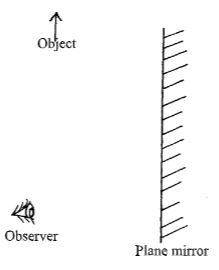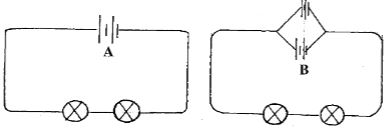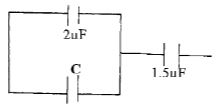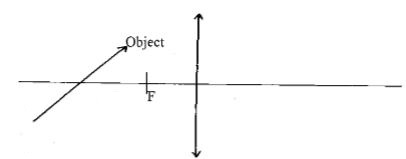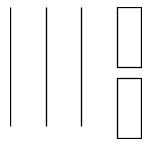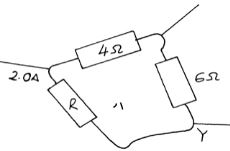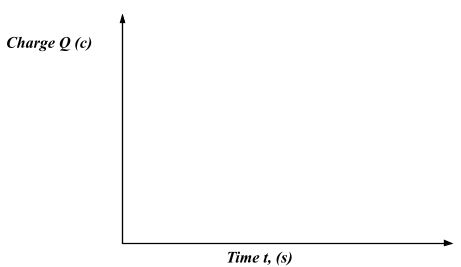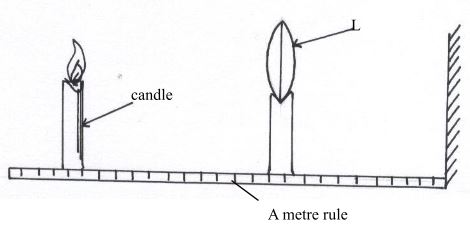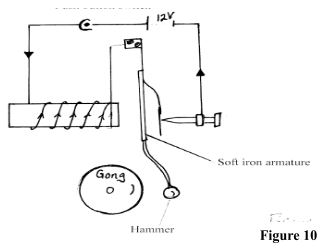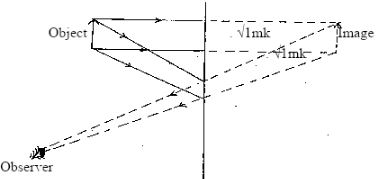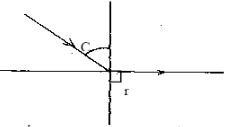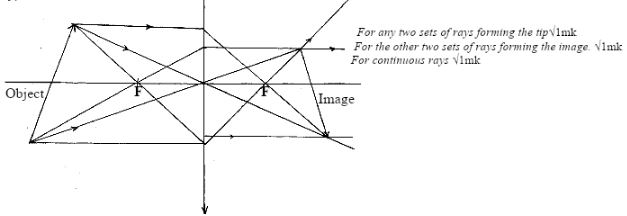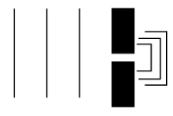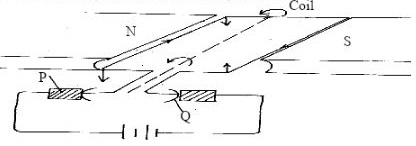PHYSICS
PAPER 2
INSTRUCTIONS TO CANDIDATES:
- Write your name and index number in the spaces provided above
- This paper consists of two sections A and B.
- Answer all questions in section A and B in the spaces provided.
- All working must be clearly shown in the spaces provided.
- Mathematical tables and electronic calculators may be used.
SECTION A (25MARKS)
Answer all the questions in this section
- A polythene rod can be charged by rubbing it with a cloth but a brass rod held in the hand cannot be charged this way.
- State what happens when the polythene rod is being charged. (1mk)
- Explain why the brass rod cannot be charged this way (1mk)
- Figure 1 below shows an object placed infront of a plane mirror. Draw appropriate rays to locate the image as seen by the observer. (2mks)
- A student in a school in Rachuonyo South constructed an electric bell. When he switched it on, the bell just rang once and not continuously. Identify the possible fault in the bell (2mks)
- A magnifying glass of focal length 50mm produces a virtual image three times the size of the object. Use the lens formula to find the position of the image. (3mks)
- Figure 2 below shows two circuits with identical dry cells and identical bulbs;
- In which circuit will the bulbs be brighter (1mk)
- Give a reason for your answer in (i) above (1mk)
- Three capacitors are arranged as shown in the figure3 below. If the effective capacitance of the circuit is 1.25F, calculate the value of C (3mks)
- A referee standing in a football field some distance from a wall blows a whistle and hears its echo 1.6 seconds later. How far is the referee from the wall?
(Speed of sound in air = 340m/s) (3mks) - Define the term critical angle as used in refraction of light (1mk)
- Figure 4 below shows an object placed infront of a convex lens.
Complete the ray diagram to show the position of the image. (3mks) - A charge of magnitude flows through a point in 15 minutes. Calculate the current. (2mks)
- Which part of the electromagnetic spectrum plays a major role in the green house phenomenon (1mk)
- Complete the diagram below in figure 6 to show the shape of the wave fronts after passing through the deep gap (1mk)
SECTION B(55MARKS)
Answer all the questions in this section
- Figure 10 shows a simple d.c. motor;
-
- name the parts labeled P and Q
- Explain why the pole pieces are curved (1mk)
- Show the direction of current flow in the coil and the direction of rotation of the coil (1mk)
- State two ways in which the motor would be modified to rotate faster. (2mks)
- Explain what would happen if alternating current was used in the motor. (2mks)
-
-
- State Ohm’s law (1mk)
- In the circuit shown in figure 11 below, the total resistance between X and Y is 2 Ω;
- What is the resistance of the resistor R (3mks)
- The total current flowing through between X and Y is 2.0A. What is the current in the 4Ω resistor? (3mks)
- state three factors that affects resistance of a metallic conductor (3mks)
-
- Identify the factors that affect the capacitance of a parallel plate capacitor (2mks)
- On the set of axis shown in figure 12 below, show how the charge of a capacitor varies with time for a discharging capacitor. (1mk)
-
- The diagram below shows an experimental set up consisting of a mounted lens, L, a screen, S, a metre rule and a candle.
- Describe how the set-up may be used to determine the focal length, f of the lens. (5mks)
- State the reason why the set-up would not work if the lens were replaced with a diverging lens (1mk)
- The graph below shows the relationship between and for converging lens where u and v are the object and image distances respectively.
From the graph, determine the focal length, f, of the lens. (5mks) - An object placed 15cm from a convex lens is magnified two times. Determine the focal length of the lens. (3mks)
- The diagram below shows an experimental set up consisting of a mounted lens, L, a screen, S, a metre rule and a candle.
-
- State the motor rule. (1 mark)
- Sketch the resultant field pattern around the following current carrying conductors and show the direction of the forces acting on the conductors. (3 marks)
- Figure 10 shows an electric bell.
- Describe how the electric bell works (5 marks)
- Explain what would happen if the armature is made of steel (2 marks)
- What adjustment should be done to the system to make it operate effectively with a lower voltage battery? (1 mark)
-
- An angle of reflection of a reflected ray from a plane mirror is 200. If the mirror is rotated through an angle of 250 , calculate the angle between the incident ray and the new reflected ray. (2 marks)
- A concave spherical mirror has a focal length of 10 cm. Calculate the distance where an object must be placed in order to produce a real magnified image three times the size of the object. (3 marks)
- An object is placed 20 cm in front of
- a plane mirror
- a concave mirror
State two differences between the images formed in each case. (2 marks)
- State one application of each of the following. (2 marks)
- convex mirror
- parabolic mirror
MARKING SCHEME
-
- Some electrons from the atoms of the cloth pass over to the rod so that the rod has extra elections
and becomes negatively charged. Polythene rod is an insulator and does not conduct the charges to
the hand. √1mk - The electrons generated from the cloth are conducted away the brass rod to the hand which earths the rod by conducting or absorbing the electrons due to its potential. √1mk
- Some electrons from the atoms of the cloth pass over to the rod so that the rod has extra elections
-
- Use of a steel core that forms a permanent magnet when current is passed through the solenoid. √1mk
- f = 50mm, m = 3
1/f = 1/u + 1/v
but v/u = m
v/f = m + 1
v/50= 3+1
v=200mm -
- B √1mk
- In both A and B the voltage is the same while current in B is twice the current in A
1 + 1 = 1 = 1
2+c 1.5 1.125 Cr
- C=2.5uF√1mk for correct expansion leading to CT. √1mk for correct substitution.
- 2 x distance = speed x time OR distance (s) = speed x √1mk
2 x S = 340m/s x 1.6seconds S = 340x 0.8 √1mk
S= 340 x 1.6 = 272m √1mk
2
= 272m - It is the angle of incidence in one medium for which the angle of refraction in the other medium is 90o. √1mk
-
- Infra-red radiation √1mk
-
(For correct illustration of emerging wave joints curved at corners) √1mk -
-
- P – carbon brushes; √1mk
Q- split ring commutation√1mk - To concentrate magnetic field in the small space√1mk
-
- P – carbon brushes; √1mk
-
- Using more than one coil /increasing the number of coils √1mk
- Increasing the magnitude of the current √1mk
- If an a.c current was used the coil would turn in one direction during the positive half cycle and in the other direction the negative half cycle. The oil would not turn continuously √1mk
- a.c voltages can be stepped up; and down √1mk
-
-
- The current through a conductor is directly proportional to the potential difference across the conductor provided temperature remains constant i.e (=constant) √1mk
-
- √3mk
1/2 = 1/R + 1/10
1/R= 1/2 - 1/10
1/R= 5-1/10
1/R= 2/5
2R=5Ω
R=2.5Ω - Divide 2.0 in the ratio 10:25 i.e 4:1 √1mk
This will be 1.6 and 0.4A √1mk
Less current flows through the circuit with high resistance i.e 0.4A passes through the 4.0Ω
(as well as 6Ωresistor. √1mk
- √3mk
-
-
- Area of overlap of plates
- Separation distance of plates
- Presence of dielectric
(1mk for each two correct answers in that order)
-
-
-
-
- Adjust the position of the lens back and forth until a sharply focused image is formed on the screen. Start by pushing the lens to the front until you reach a position where the candle flame is focused on the screen. Measure, u and v and record in a table.
Now push the lens backwards gradually until a new position is reached where the image is once again focused on the screen and once again measure u and v.
apply the formula 1/f = 1/u + 1/v
- Adjust the position of the lens back and forth until a sharply focused image is formed on the screen. Start by pushing the lens to the front until you reach a position where the candle flame is focused on the screen. Measure, u and v and record in a table.
- A diverging lens would spread the light in a divergent manner instead of focusing it to a point.
-
- From the graph.
1/u = 2 x 10-1
at 1/v =0
1/f = 1/u = 1/2 x 10-1 ⇒ f = 10/2 = 5 - m = v/u ⇒ 2 = v/15
∴v = 15 x 2 =30
1/f = 1/u + 1/v ⇒ 1/f = 1/15 + 1/30 = 2+1/30 = 3/30
-
-
- Fleming's hand rule: If the thumb and second fingers of the left hand are held at right angles to each other, then if the first finger represents the direction of magnetic field and the seconf finger the direction of current , thumb represents the direction of motion.
-
pattern of field,
direction of field,
direction of force - when the push button switch is pushed on, current flow ; the soft iron core is magnetized; Soft iron core (magnetized ) attract, the soft iron armature and the hammer hits the gong ;
- Meanwhile the contact is broken stopping current flow. The core demagnetized releases the armature and the hammer goes back; The process is repeated again ;
- If the armature is made of steel ; the hammer hits the gong and remains there / the bell rings once ; this is because steel acquires permanent magnetism ;
- the soft iron core should be u – shaped ;
- the diaphragm can be made to vibrate using sound input ; As the coil attached to it vibrates cutting the magnetic fields of the magnet; current is induced in it which can be amplified and directed to another loud speaker;
Download Physics Paper 2 Questions and Answers - Kapsabet Pre Mock Exams 2021/2022.
Tap Here to Download for 50/-
Get on WhatsApp for 50/-
Why download?
- ✔ To read offline at any time.
- ✔ To Print at your convenience
- ✔ Share Easily with Friends / Students

